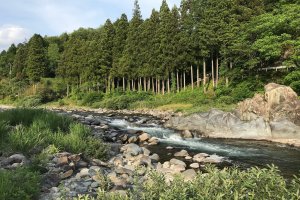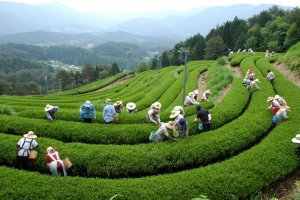Heikoncha! Welcome to Higashishirakawa.
Only two villages remain in Gifu prefecture; Shirakawa-go and Higashishirakawa village. They may share the name 'Shirakawa' (and Higashi just means "east") but they are very different and distant communities.
Higashishirakawa village is a quaint village in east-central Gifu of about 2500 people spread out in a series of steep valleys hugging the Shirakawa river and located between Gero, Nakatsugawa, Ena and Shirakawa-cho. It is not on any major highways and is often overlooked but for those who visit, they will be treated to hospitality, kindness and traditions stemming from glorious food to a local dialect preserved for the generations.
The Shirakawa river starts in neighboring Kashimo (Nakatsugawa) but in Higashishirakawa it is not as controlled which creates perfect conditions for Ayu (River trout). Though not a huge pull for tourists world wide, for the fly fisherman, this river provides some of the best fly fishing experiences in all of Japan. From its rumbling white-water-like flow in Oppara to the calm of Kando and back to narrow rush of Goka, there is a condition for every fisherman.
Like Nakatsugawa, Higashishirakawa was under the Naegi Shogun and thus could only practice Shinto. This is true to this day. There are shinto shrines all over the village with the largest at Kando located next to the village hall. The people are firm followers of the religion and many youth are unaware of the practices of Buddhism, Japan's other major religion.
Though it is a place of faith, they are also people of the earth. Tea bushes line the more open areas and the sides of terraced hills. Managed Hinoki, Japanese cypress, blanket the mountains with dots of deciduous trees fill where an area was once cleared. The vegetables grown have had the best soil resulting in the crispiest carrots and cucumbers and the juiciest tomatoes.
There is one event that has put Higashishirakawa on the map; The Tsuchinoko Festival. Tsuchinoko are a mythical beast that looks like a short fat snake. While there are a few communities around Japan that claim themselves as home of the tsuchinoko, the roots of the myth can be traced to "central Gifu"; Higashishirakawa. The village has maintained an award of ¥1,230,000 (increases by ¥10,000 each year) for the person who captures a tsuchinoko. So every year at the festival, hundreds of people go hiking through the forests in search of this dangerous beast. Now you may not think it is true but Higashishirakawa village has a claim of having the most witnesses in all of Japan.
With a nice selection of places to stay, fun festivals, great fishing and plenty of outdoor activities, Higashishirakawa is the home of family, faith and fantasy.





























